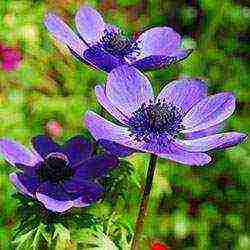Content [show]
Hello dear readers!
Garden strawberries are one of the most delicious, tender and favorite berries of gardeners.
People call it strawberries, although in official science it is forest small fragrant berries that bear this name.
If you are going to start this valuable and popular culture on your site, then today we invite you to get acquainted with the common methods of planting garden strawberries and the features of caring for it.
Previously, we have already got acquainted with garden strawberries, decided on the choice of a planting site and prepared seedlings, and now we will start planting strawberries.
Also in this article we will talk about how to properly care for it in order to get a good harvest.
And although our beauty is not capricious and will not require great labor feats from us, but still, like all plants, the strawberry loves to be treated with love and given due attention.
Landing patterns
As we already know, strawberries can be planted in spring, when the soil warms up, and in late summer - early autumn.
And seedlings purchased in pots can be planted all season long.
There are several main ways of planting garden strawberries, namely: single-line or ordinary, two-line or ribbon, square-nested or checkerboard.
Such planting methods are used mainly on flat and dry places.
If your plot is wet and there is a possibility of stagnant water in rainy weather, then it is better to grow garden strawberries in high beds (20-30 cm).
I prefer to grow it in higher elevations, as I find it more convenient.
Firstly: excess moisture leaves the soil faster, secondly, strawberry bushes are much better illuminated by the sun, and thirdly, it is much easier to care for the plantation.
And now a little more about each method of planting garden strawberries, which have their own disadvantages and advantages.
Planting in separate bushes... The seedlings are placed at a distance of 45-60 cm one by one, and to exclude interlacing, the mustache is regularly removed.
This allows the plants to thrive with increased intensity and good fruiting.
The disadvantage of this method is its laboriousness - the obligatory carrying out of frequent weeding and loosening, mulching and removal of the mustache.
However, abundant nutrition for each bush guarantees a bountiful harvest with large berries.
Additional advantages are savings in planting material and good ventilation, thereby reducing morbidity.
Planting strawberries in rows (single line)... The bushes are planted at a distance of 15 cm, placing them in rows with a gap of 40 cm between rows.
This is done for free access to the landings. The complexity is the same as when planting strawberries in separate bushes: it is necessary to loosen, weed, remove the mustache.
Advantages - increased yield due to the growth of bushes in the rows and the possibility of obtaining high yields for 5-6 years, while not renewing the planting.
Two-line (ribbon) fit... It is used for large areas of planting in order to reduce labor costs for processing the site.
The plantings are placed in two lines at a distance of 30 cm, placing the seedlings every 15-20 cm and leaving a passage 60-70 cm wide in the aisles.
Thus, they provide access to each plant and reduce the size of the area required for weeding and loosening.
Checkerboard landing... It is used when laying a ridge of a variety of garden strawberries with increased leafiness.
In this case, the seedlings are placed in rows at a distance of 50 by 50 cm, while shifting one row relative to the other by 25 cm.
This provides good ventilation during the growth of bushes and prevents morbidity.
Planting nests... A well-developed seedling is placed in the center, and around, at a distance of 6-8 cm, another 6 smaller ones are planted.
25-30 cm are left between the nests, and they are placed in rows with row spacings 35-40 cm wide.
The main disadvantage of this method of planting strawberries is the consumption of a large amount of planting material.
However, with the growth of the bushes, labor costs are reduced, and fruiting becomes much higher than with traditional schemes.
Carpet planting of strawberries... The simplest and easiest growing method.
In this case, all the mustache is left for rooting. Such plantings almost do not need weeding - the seedlings of the plant simply do not allow anything else to grow.
They also do not require intensive watering - under a continuous carpet of leaves, the soil dries out slowly.
This method is the best way out for rarely visited areas, since it does not require special care.
The only drawback is that over time, the culture degenerates, and the berries become small.
Important! When choosing a landing pattern, calculate your capabilities, and also take into account the goals that you have set for yourself. If you want to grow garden strawberries for a commercial purpose, do not be lazy to study as deeply as possible all the nuances of planting and care.
Planting methods for garden strawberries
Planting bushes on an ordinary garden bed is the most traditional method, providing average yield under average climatic conditions.
Today, Russian summer residents and farmers are actively using technological innovations that make it possible to obtain higher and better yields while reducing labor costs.
Planting strawberries on agrofibre... For planting, high ridges are formed, the width of which depends on the width of the nonwoven material. Usually it is 70-80 cm.
The ridge is covered with agrofibre, pressed along the edge with heavy improvised means (boards, slate, bricks, earth).
The usual placement is in two rows. Row spacing - 50 cm, between seedlings - 20 cm.
At the designated points, minimally small round holes are made (for the film, so as not to tear) or cross-shaped.
Dig a hole with your hand and place a seedling in it. If the roots are long, then they take a long wide knife with which they make a hole and then press down with the earth.
Or cut the roots to the desired length (up to 10 cm). If moles are found on the site, then first get rid of the pests, it will be problematic to do this after the construction of the garden bed.
Planting strawberries on a straw mattress... At the end of summer, dried pea tops are dropped on the garden bed and spilled with nitrogen fertilizers, which provide rapid overheating.
After 3 weeks, well-developed seedlings are planted with an interval of 30-40 cm in several rows, they are well shed and mulched.
The main rule when placing is good access to each plant;
Landing in film tunnels... This method is good for northern regions or areas with a harsh continental climate.
The film shelter will protect young tender seedlings from the vagaries of the weather.
However, with significant warming, the film must be removed or vents must be built, since excessive temperature and humidity will contribute to the development of diseases.
Landing in a vertical ridge... With a shortage of space in the summer cottage, it is possible to grow garden strawberries in vertical beds.
For the construction of such a bed, any available material is required: plastic bags, wooden or plastic barrels, containers, car tires or discs.
It is quite simple to build a ridge by making holes for seedlings in the material at hand and filling containers or barrels with earth.
To ensure sufficient watering and feeding along the entire length, a pipe with small holes made at the required level is inserted into the center of the structure, through which moisture enters.
Such plantings are especially vulnerable during the cold season, so they are carefully wrapped up for the winter.
Important! When planting in any way, place the heart of each seedling above the soil level. At the same time, the root collar should be completely covered with soil. Ideally, the growing point of each plant should be just above the soil level and not be covered with earth, otherwise the plant will die.
How to arrange landings
To achieve the highest productivity (of course, if there is free space), you should start 4 beds with constantly renewed plants:
- On the first site in the fall, bushes of garden strawberries are planted. Next year you will receive high-quality seedlings from this ridge, with which you will plant a second plot;
- A year later, from the second plot, strawberry seedlings are planted in 3 plots, and on the first you get a full-fledged harvest;
- After 2 years, you will have two perfectly fruitful beds, one ridge with young strawberries, and you will plant seedlings on the last plot;
- After 3 years, 1 plot is dug up - after all, it has already borne fruit for 3 years, and young seedlings are planted from 4 sites.
However, transplants alone cannot provide high yields. It is necessary to provide your pet with optimal conditions for good fruiting.
Planting young seedlings
Seedlings of garden strawberries are planted in the spring (20.04 - 10.05) or in the fall (16.08 - 31.08):
- Before planting, the seedlings are kept in a cool room for at least 5 days;
- The best time to plant is in the afternoon;
- Excess leaves are removed, especially old and dried ones, leaving only two inner green leaves. This is a prerequisite for good survival. Otherwise, the root system may not be able to cope and the plant will die;
- The roots are dipped in a mash made of equal parts of clay and peat;
- Place the seedling in the hole, having previously straightened them along the entire length. The ideal option is to make a mound and "plant" a bush on it, placing the roots along the edges. At the same time, they do not forget about the main rule when planting garden strawberries - do not cover the heart with earth. It should be slightly above the soil level, and at the same time the root collar should be completely in the ground;
- After placing the seedling in the hole, the soil around is squeezed and leveled, while making sure that the roots do not remain hanging in the void, but have full contact with the ground;
- After planting, watering is carried out (in dry weather - plentiful).
Important! If you bought strawberry seedlings in cups, then the roots will be necessarily twisted. They should be straightened, rotted away, and, if necessary, shortened. Correct planting will increase the chances of good survival of the bushes.
Care features
Young strawberry seedlings need increased attention in the first year, especially at the initial stage, when they have not yet taken root:
- In hot weather, in the first few days, the seedlings are shaded, and watering is done as needed. If late frosts threaten spring plantings, then the plantation is protected with covering materials;
- When planting, the hole is spilled well and must be mulched, this allows you to lay a ridge in any weather - the mulch retains moisture;
- Top dressing is carried out together with adult plantings, but the rates are halved - the plant is still small;
- In spring plantings, peduncles and mustaches must be removed, this will give an additional incentive for the growth and development of the bush.
Important! Waterlogging of the soil can lead to the appearance of diseases, decay of the roots. Therefore, pay special attention to the humidity. Drip irrigation is optimal in this regard - the soil never dries up and does not become waterlogged.
Adult planting care
Garden strawberry is an unpretentious plant; immediately after the snow melts, you can see green leaves.
In the spring, when the soil warms up, they clean the plantings from dead leaves, plant new seedlings in the place of the frozen bushes, and treat the plants from pests.
As soon as the weather permits, they begin to carry out gardening work on transplantation and care.
Weeding, loosening, mulching
When planting garden strawberries in the usual way, without using agrofibre, you should prepare for regular weeding and loosening throughout the season - at least once every 2 weeks.
Ridges with separately planted bushes are especially costly in this regard. Therefore, in large agricultural farms, a planting scheme is used in rows, which makes it possible to process plantations using mechanized means.
For the whole season, 5-6 weeding and 7-8 loosening are carried out. At the same time, special attention is paid to the accuracy of any actions near the roots - after all, they lie close enough to the surface and are easily exposed.
If this happens, you should sprinkle them with a layer of soil and trample them down.
This happens especially often after wintering, when the bushes protrude above the surface due to frost. In this case, they are slightly huddled.
Some professionals advise to remove a 3 cm layer of soil during the first spring weeding, in which the larvae of pests hibernate.
In this case, the soil warms up faster, and the bushes of garden strawberries start growing more actively.
If your climatic conditions allow, then it is quite possible to use this recommendation.
After weeding, mulching is carried out with improvised materials:
- Sawdust;
- Pine needles;
- Overripe straw;
- Old leaves;
- Reed.
The first mulching of strawberries is done after the spring weeding, covering the soil around the bushes with a layer of 7-8 cm.
During the season, if necessary, mulch is poured, and the weeds that have broken through are weeded out.
Important! A layer of mulching materials also retains moisture and protects the berries from contamination. And if you make pine needles mulch, then add a disinfectant effect that prevents the development of diseases and even repels pests.
Watering garden strawberries
One of the main points of proper care of garden strawberries is timely and sufficient watering.
If we talk about garden strawberries, then they are especially demanding on soil moisture during flowering and fruiting.
With sufficiently light loose soils, watering is carried out more often, and if there is clay in the composition, less often.
Basic requirements for watering:
- Before flowering, sprinkling watering is allowed, after - only at the root. If your plantings are placed on agrofibre, then watering is carried out through a hose with holes, laid in advance during the construction of the ridge;
- The frequency of watering is 1 time in about 10-12 days, however, in extreme heat, the frequency is increased several times;
- Watering is carried out with warm water, if impossible - shed furrows between the rows;
- For 1 sq. consume about 10-12 liters, the rate is increased or decreased depending on the degree of soil moisture.This is especially important during the fruiting period - the earth should be moist to a depth of 20-25 cm;
- Watering is carried out in the morning, and preferably in the evening, in order to give the plant the maximum necessary moisture.
If you have small plantings, then it is advisable to cover them with a film for the period of flowering and fruiting in rainy weather - this will help protect garden strawberries from the development of diseases.
Important! Before harvesting, abundant watering is stopped - the berry turns out to be especially sweet and not watery. To prevent planting from drying out in hot weather, watering is carried out after each collection of ripe berries.
Feeding
Nutrition, along with watering, plays an important role in shaping the future harvest of garden strawberries.
If you took care of the fertility of the soil in advance, then in the first year, in the absence of berries, you can get by with a minimum of inorganic fertilizers.
However, starting from the first fruiting season, you need to regularly feed your pet in order to get the appropriate return:
- First feeding carried out after the appearance of young leaves, at the same time, last year's leaves are removed. For 10 liters of water take 1 tbsp. l. liquid "sodium humate" or urea. Consumption for 1 bush - 0.5 l. Or bred mullein (1: 10) or chicken manure (1: 50) and add the same amount of solution. To enhance growth and fruiting, foliar feeding is also carried out: dissolve in a bucket of water 2 g of potassium permanganate, boric acid and ammonium molybdate;
- Second feeding carried out just before flowering. For 10 liters of water take 1 tbsp. l. "Agricola Aqua" and "Effekton Ya", add potassium sulfate (1 tsp) and pour 0.5 liters of solution under each plant. At the same time, another foliar feeding is carried out;
- Third feeding produced after harvest (before August 10), its goal is to ensure the full development of flower buds for the next year. For 10 liters of water take 1 tbsp. l. "Effecton" and nitrophoska, add a glass of wood ash. For each bush, 1 liter of solution is consumed.
All the necessary components can be replaced by a special complex fertilizer, which is created only for garden strawberries and provides an increase in yield by 30%.
Important! When carrying out dressings, try not to get fertilizer on the leaves, and also take into account the amount of moisture in the solution during watering. After all, waterlogging is one of the main factors contributing to disease damage.
Mustache removal
Trimming the whiskers allows the garden strawberry bush to conserve the most energy for high yields.
However, such a seemingly simple action also requires adherence to certain points:
- Pruning twice a year - in the spring before flowering and after fruiting;
- To remove the mustache, be sure to use garden tools: scissors, knife, pruner. Tearing off the whiskers can damage the plant and even pull it out of the soil - the whiskers are quite strong;
- Do not remove the mustache at the root, leave the stalk up to 10 cm - later the plant will get rid of the unnecessary stem by itself;
- Prune early in the morning or in the evening, and then do a pest control.
Important! To obtain high-quality planting material for garden strawberries during the fruiting period, mark the most productive bushes. You will remove the mustache on them when the time comes to lay a new ridge - in the fall. For seedlings, take only the first mustache from the mother plant - it is they that have the highest qualities of productivity. By this selection, some gardeners increase the yield of already good varieties and even develop new ones.
From all the available options for planting garden strawberries, choose the most suitable for achieving your goals - whether it is growing for profit or to provide your family with a vitamin and tasty product. In any case - success to you!
For information, watch the video on another way to plant garden strawberries. Maybe some of you would prefer this fit.
See you soon, dear readers!
You can also read on this topic:
Tags: strawberry
Perhaps there is no person who does not like fresh berries. Planting garden strawberries and caring for a berry in the country will provide the family with both fresh fruits and various tasty preparations. There are many cultivation methods: in the open field, in a greenhouse, and in boxes on a windowsill or balcony. Bushes are propagated vegetatively or grown from seeds. Both southerners and residents of the northern regions know this berry, it is not too demanding on the climate. The plant is often called a strawberry, but this is not entirely true. Strawberries are commonly found in the wild, on lawns, and are of many different types.

Which varieties to choose
One cultivar can be cultivated in the garden, but the fruiting period for the main species is usually very short. You will enjoy fresh berries for about 2 weeks, and then you will only eat jams and mashed strawberries with sugar. Experienced summer residents harvest all summer, and sometimes from early spring to late autumn and even winter, growing bushes in a greenhouse.
To keep the berries on the table all season, choose about 5 different types of seeds with different ripening times. At the same time, keep in mind that garden strawberries are not very capricious, but when grown in an unsuitable climate or soil composition, they may not give a large yield. Assess the weather and soil conditions of your site - and you can purchase planting material. Read the instructions on the bags, ask the seller, but it is better to give preference to zoned varieties.
The selection criteria should be:
- resistance to climatic features: frost, heat, drought;
- requirements for soil properties;
- good resistance to diseases and pests;
- timing and duration of fruiting;
- yield;
- the taste of berries.
In some cases, the gardener makes additional requirements for the variety. If you want to grow berries not only for yourself, but also for sale, the presentation and the ability to tolerate transportation well are important. Large fruits are not always suitable for jam, small strawberries boil better and retain their shape. Some summer residents do not like to change the plantation every 3-4 years and prefer long-lived varieties. For cultivation in a greenhouse, special requirements are imposed on the qualities of strawberries.
Early varieties of garden strawberries:
- Marshmallow;
- Kama;
- Enchantress;
- Dawn.
Strawberries, medium ripening:
- Festivalnaya;
- Cinderella;
- Marmalade;
- Fairy.
Bushes with a late harvest:
- Zenga-Zengana;
- Black Prince;
- Pandora.
If it is difficult to find varieties with late ripening periods, purchase remontant species. Their fruiting period is long, the harvest can be harvested before frost. Breeders have bred garden strawberries that can bear fruit twice a season. The first collection takes place in early summer, then the berries will appear in the fall. If you want to purchase such plants, make sure that the weather conditions in your summer cottage are suitable for them. Long-fruiting varieties are also suitable for growing in a greenhouse.

Site selection and preparation
Much of the quality of the crop depends on the seeds, but no less important is the place where the strawberries will be grown. First of all, read the instructions on the seed bag. Most varieties require a lot of sun, but there may be exceptions. Choose a high area that is not shaded by any buildings or vegetation. You can plant bushes on the south side of fences, buildings or trees. This option is convenient because the landings will be protected from cold northerly winds.
The berry does not like steep slopes, although on a surface inclined at a slight angle to the south, it will feel great. Drafts are contraindicated for plants.Near ground waters are also undesirable, they can cause fungal diseases or adversely affect the quantity and quality of the crop. If your garden is in a damp lowland, make good drainage or raise raised beds.
Strawberries will like light sandy or loamy soils. She will not like either too acidic or alkaline soil, the reaction should be close to neutral. It is good if, before that, legumes, celery, onions or carrots grew in the beds. It is better to dig up uncultivated land in the fall, select all the roots and sow siderates.
The beds need to be prepared half a month before planting the bushes. For each square meter, apply 50 g of complex mineral fertilizers and 10 kg of last year's manure. Strawberries do not like fresh manure, and they also do not like fertilizers with chlorine. Dig well and loosen the soil, and then leave it for 2 weeks to compact the soil.
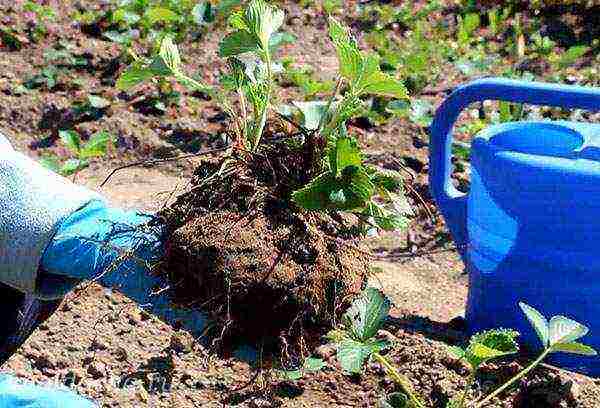
Reproduction of garden strawberries
There are several ways to obtain planting material for garden strawberries. If you need pure varieties that have all the qualities described in the catalog, buy seedlings in a specialized center. You can take them from neighbors or friends, but then you cannot be sure that the plant has all the qualities of its variety.
There are 3 ways to breed strawberries:
- dividing the bush;
- planting shoots;
- growing seedlings from seeds.
The safest way is to take the antennae from the bush. In this way, in abandoned dachas, garden strawberries spread throughout the territory. Choose strong plants with good yields and large, tasty berries. The best shoots are harvested from bushes at the age of 2-3 years. Wait until fruiting ends and cut the rosettes closest to the main plant.
Choose a sturdy shrub between 2 and 4 years of age for dividing. The work can be done in the spring before flowering or in the fall after harvest. Dig up the plant and cut off a piece with a good root system and at least one rosette of leaves. After dividing, all parts must be immediately planted in the ground.
Growing strawberries from seeds does not guarantee that the bush will retain its varietal qualities. An exception is the seed sold in sachets. You can pick large ripe berries, cut off the peel with grains, grind these pieces into gruel and dry. Collect the seeds, keep them in a damp cloth for 2-3 days, and then sow them in pots for seedlings. The sprouts will be very weak, they should spend the winter at home or in a greenhouse with heating.
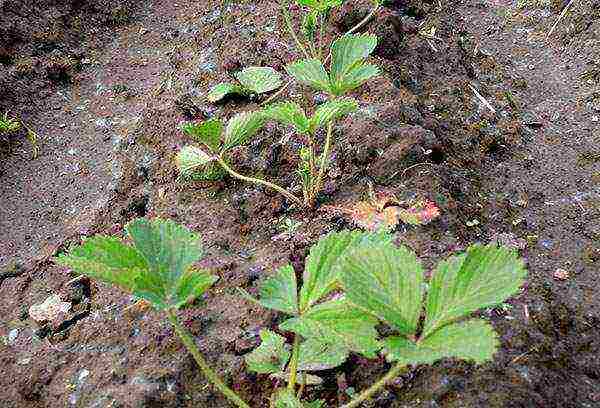
Planting bushes
There is no general opinion among summer residents about which is preferable: planting strawberries in spring or autumn. If you plant young bushes in May, they will get stronger by autumn and winter well. You can do this work at the end of August, then next summer you will taste fresh berries. Just take into account the climate of your area: the plants will take root for about 3 weeks, at which time they need warm soil. If you received planting material in a cold season, dig it in the greenhouse, and move it to the garden with the onset of warmth.
In the spring for planting seedlings, dig holes and spill them well with water. Throw some humus and ash on the bottom. Dip the roots of the plants in a clay mash, and straighten them well when planting. The pits should not be deep, there is no need to bury the root collar. Bury the plants, water them with water to compact the soil. Dry soil will have a bad effect on the survival rate of strawberries, pour compost or loose humus around the plantings. In the same way, bushes grown from seeds are planted in the spring.
Advice
Purchase open-root seedlings only from trusted retailers. Plants can be without soil for no more than 2 days, then they do not take root well. In the market, you may be sold a stale product.
Do not plant the bushes too densely, they need space for good development. You can plant in one row with a distance of 0.5 m between plants.If you want to arrange a large plantation, keep the distance between the rows at least half a meter. It is better to have fewer bushes, but with large fruits, than many microscopic berries.
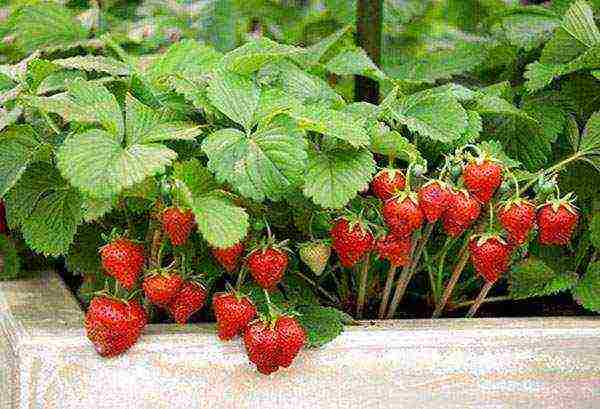
Strawberry care
When planting the strawberries is complete, provide the young bushes with good care so that they get stronger and winter without problems. Water it with warm water at least once a week. If the heat is intense, add additional moisture to the soil after 3-4 days. You can install a drip irrigation system, then the soil will not dry out, and the water will flow to the roots evenly.
Advice
If you are growing remontant varieties that require a lot of moisture for the constant formation of fruits, water the garden every day in dry weather.
Plants need nutrition. In the spring, feed the bushes with nitrogen, when the buds appear and the strawberries bloom, they need phosphorus. When the berries ripen, apply a complex mineral fertilizer, and before wintering, pour with potassium preparations. Spud the bushes periodically, this will stimulate the growth of additional roots. Strawberries are a very neat berry, it does not tolerate the neighborhood of weeds. Weed the beds constantly.
In the spring, immediately determine which plants are needed for harvesting, and from which you will take a mustache for planting on a site or in a greenhouse. In the first case, cut off all the emerging shoots, in the second, remove the buds. When the crop is harvested, you cannot leave the bushes unattended. At this time, buds are formed for the next harvest. Do not forget about feeding and watering.
In order for young bushes to gain strength before a long winter, they need to be fed with phosphorus and potassium before frost. Before frost, mulch the bed with compost, dry grass, or fallen leaves. Cover the bushes with spruce branches or corn stalks for the winter. The vegetation will keep the ground warm and prevent the wind from blowing snow off the ground. Sprouts that emerged from seeds this summer cannot be planted under the snow; keep them at home until spring.

Protection against diseases and pests
Mostly strawberries are affected by fungal diseases, such a problem also exists when growing a berry in a greenhouse. A fluffy bloom on all aerial parts of the plant will help to recognize the problem. Fighting infection is difficult. Severely damaged bushes must be removed, the diseased parts must be cut off from the rest and the rest must be treated with antifungal drugs.
To prevent illness, you should:
- remove weeds;
- do not allow too dense planting;
- do not apply fresh manure;
- remove all dead and dried leaves.
Sometimes there are other problems as well. The bushes can be attacked by ticks and nematodes. If you see shriveled yellowed leaves, treat the plantation with colloidal sulfur. Bulges and growths on the leaves indicate the appearance of nematodes. Affected specimens need to be burned, and the area should be sprayed with insecticides.
Birds love to feast on berries. It is not necessary to completely expel the birds from the dacha, but it is necessary to drive them away from the berries. There are many options: scarecrow, ultrasound, shiny pendants. These methods do not always help. Try a more reliable option: put a cat on the site for the summer. The best bird guard is hard to come up with.

Fresh berries all year round
If you want to feast on berries all year round, grow strawberries in a greenhouse. The building material must have good thermal insulation; a heating system is required inside. The room should be equipped with lighting fixtures. Plants need moist air. You can spray the plantings yourself from spray guns or purchase an automatic system.
When buying planting material, be sure to check if this species can be grown indoors. To make it easier to care for the plantation, choose hardy, not too demanding on lighting, self-pollinated varieties. You can grow seedlings at home from seeds, and then transfer them to grow in a greenhouse.
How to plant strawberries indoors? There are different options. If space permits, you can arrange boxes, containers or plastic sleeves with earth on the shelves. To save space, position the bags or pipes vertically and make holes in the sides for planting shrubs. The rest of the care is almost the same as in the open field: feeding, watering. If necessary, the flowers should be pollinated with a brush. Provide the strawberries with at least 10 hours of daylight, and soon you will taste the winter berries.
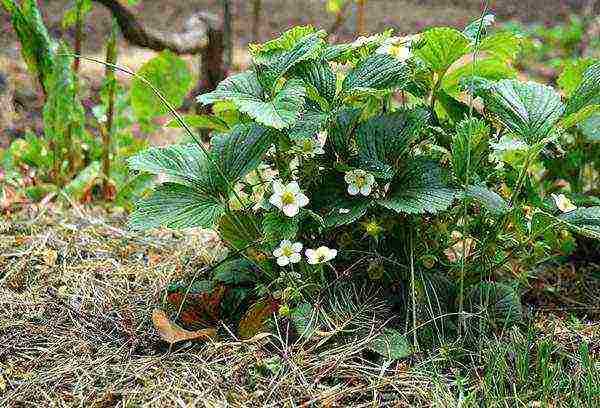
Conclusion
Strawberries can be grown outdoors, in a greenhouse, and at home in flower pots. Basically, planting material is obtained by dividing a bush or harvesting shoots, but you can also grow seedlings from seeds. Varieties should be chosen depending on the climate and soil in your area.
Choose a sunny location for planting. Plants should be spacious. If the plantings are too dense, small berries grow, and the strawberries themselves begin to hurt. Care consists in timely watering, feeding, loosening and weeding.
After harvesting the berries, continue to water and feed the plants, at this time the harvest of the next year is laid. To obtain seeds, cut off the top layer of pitted pulp from ripe fruits. Varietal qualities may not be preserved, but it is possible that you will develop a new interesting species. Do your best to take care of your pets, the taste and aroma of strawberries are well worth the cost.
How to grow garden strawberries: choosing a place

Growing garden strawberries in the photo
Growing garden strawberries begins with choosing a place. This culture should be allocated as flat places as possible or with a small (up to 5 degrees) slope, protected from the wind, with light and medium loamy and sandy loam chernozems, with a permeable subsoil.
The best lands for growing strawberries in a garden plot are virgin and perennial deposits. Other lands must be prepared by previous crops.
In open places, especially in the Volga region, to retain snow in order to protect strawberries from freezing, protective plantations of forest and fruit trees are planted around the plantation, and berry bushes (currants and gooseberries) are planted inside. Their rows should be placed in a direction transverse to the prevailing winds, at a distance of 1.5-2 m in rows and 10-12 m in a row from a row.
To ensure proper care when growing garden strawberries, you need to plant a plantation near a reservoir so you always have the opportunity to quickly water.
Strawberry plantation should not be kept in one place for more than 4-5 years, since at an older age it becomes low-yielding. Therefore, strawberries should occupy part of the plantation, and the rest of the area should be sown in the order of crop rotation with other crops, which should be the predecessors of strawberries.
The processing of the next plot for strawberries should be done in a timely manner. For spring planting, it is necessary to carry out autumn plowing to a depth of 25-30 cm with the introduction of manure and mineral phosphorus and potassium fertilizers, and in early spring it is good to fence. For autumn planting, pre-planting plowing to the same depth should be carried out no later than a month before planting (in mid-July).
Secrets of growing garden strawberries in a personal plot: caring for seedlings
In order to observe the correct agricultural technique for growing garden strawberries, you need to acquire good planting material. This culture reproduces by creeping stems (whiskers). Seedlings of garden strawberries should be pure-bred, not infected with mites. The best seedlings are annual, with a well-developed root system and large leaves on short stalks. The apical kidney (heart) must be healthy.
As a rule, seedlings should be taken from uterine plantations 2-3 years of age. However, with a lack of varietal planting material on young plantations, it is allowed to use older plantations (4-5 years or more).
In non-irrigated areas with a lack of moisture, the whiskers are usually a little rooted. In order to obtain the largest possible amount of good seedlings, it is necessary to dive the whiskers (rosettes) into a cold greenhouse or a deep ridge with loose earth. For greater looseness and moisture retention, peat and sand are added to the ground. In the second half of July - early August, when many mustaches appear on the uterine bushes, they are separated and cut into as many parts as there are nodes (rosettes) on them, both with and without roots.
Better development of the bush and a higher yield than the top ones give the rosettes of the first two nodes from the base, which must be taken into account when sorting and picking seedlings.
When caring for strawberry seedlings after sorting outlets according to the degree of development, they dive at a distance of 4-5 cm in rows and 8-10 cm in a row from a row. When picking, the outer leaves of more developed rosettes must be cut off.
When growing garden strawberries in a personal plot, the cut-out plants for the first 5-6 days need to be shaded with matting or straw and often watered. They take root quickly and give well-developed seedlings in 3-4 weeks.
Technology for growing garden strawberries: methods of planting in open ground
The timing of planting garden strawberries in the middle lane is early spring and late summer - early autumn (within the second half of August - the first half of September).
But autumn terms are preferable due to weather conditions and a greater possibility of using rooted mustache for planting.
Strawberries can be planted in one-, two- and three-line methods.
On large plantations, one- or two-line planting should be used, as more providing mechanized soil care. Planting distances should be given: with a single line 15-20 cm between plants in rows and 80 cm between rows; with two lines - 20 cm in rows, 40 cm between rows in stripes (ribbons) and 80 cm between stripes.
On irrigated plantations, planting should be carried out in furrows or deep ridges 60-100 cm wide (depending on the planting method), which are cut in advance by special plowmen.
To maintain the straightness of the rows, which makes it possible to mechanize the care of garden strawberries, planting must be done under a cord.
In recent years, a square-nesting method of planting has begun to be introduced on industrial strawberry plantations.
With this method of planting garden strawberries, nests of 4 plants are made in the corners of a square with a side of 12 cm, at a distance of 75-80 cm from the centers of the square in all directions. For the correct placement of the squares, cords are used: two control cords stretched along the edges of the site at the same distances along their entire length, multiples of the distances between the centers of the squares, and one landing with marks every 75-80 cm, stretched between the control ones in a direction perpendicular to them. Its marks must match the control cords.
When planting seedlings, pits are made by hand or with a scoop.
In order to ensure the best survival rate of seedlings, good development and yield, the technology for growing garden strawberries in the open field has determined the following rules that must be observed when planting.
- Plant the plants shallow, so as not to fall asleep "heart", as with such planting strawberries do not develop, often rot and die. Plants should not be planted too shallowly so that the roots are not exposed when the earth subsides. In a normal planting, the root collar should be at ground level.
- The ground should be firmly pressed to the roots.
- Cut the outer leaves, leaving 2 - 3 medium leaves, this reduces the evaporation of moisture by the plant.
- To avoid wilting, you need to keep the seedlings moist (spray with water and shade): planting should be timed to coincide with the falling rains or cloudy weather.
- After planting, watering - about one bucket for 6-10 plants, depending on the state of soil moisture, lining the holes with manure, humus or backfilling with dry earth. Repeat watering as needed.
Watch the video "Planting garden strawberries" to better understand how this agrotechnical technique is performed:
How to properly care for garden strawberries
And how to properly care for garden strawberries in order to get a good harvest? Strawberry plantation care is determined by the characteristics of the strawberry growth. The spring vegetation of plants begins early, due to the reserves deposited mainly in the rhizomes; the subsequent development of leaves and roots, as well as flowering and fruit formation, are due to the nutrients entering the plant. After fruiting, the further development of the strawberry plant is directed to the renewal of the leaf apparatus, the formation of whiskers, the autumn laying of fruit buds for the next year's harvest, the creation of a supply of substances for the beginning of the growing season, as well as hardening during overwintering. With age, the development of the root system is weakened in strawberries, which is the main reason for a decrease in yield and a reduction in the period of use of the plantation.
Care for strawberries in the first half of the growing season should be aimed at improving the water supply regime, ensuring moderate (but not violent) leaf growth and obtaining a good harvest.
The strawberry plantation must be kept under black fallow, systematically fertilized with manure or humus and mineral fertilizers.
In early spring, as soon as the soil is ready for processing after the snow has melted, the plantation is cleaned of dry leaves, the covering material is removed and the row spacings are loosened with a cultivator, and in the rows between the plants with a hoe.
On non-irrigated areas, after this, mulch the rows with manure, humus, etc. should be carried out, spreading the mulch in a layer of 5-6 cm.
On irrigated areas, simultaneously with loosening, humus is sealed in rows, if it was not introduced during autumn processing.
Before harvesting produce 2-3 loosening and a shelf - as needed. On irrigated plantations, 1-3 watering is carried out on the green ovary and the same amount during the period of fruit ripening.
In order to care for garden strawberries as efficiently as possible, a continuous bed of straw, tree leaves and other materials should be laid out in non-mulched areas to protect the berries from contamination soon after flowering.
Leaving in the second half of the growing season - after harvesting - is associated with preparation for wintering and next year's harvest. He must create conditions for the best nutrition of plants, ensuring the regrowth of leaves, the laying of fruit buds and good hardening for the winter.
In the post-harvest period, 3-4 loosening and a shelf of weeds should be performed. For better development of the root system, it is necessary to slightly huddle the plants when loosening. This enhances plant nutrition and better formation of flower buds for the next year's harvest. Whiskers that appear at this time in large quantities are removed if they are not needed, since they greatly deplete the bushes and reduce the harvest of the next year.
On plantations where old leaves are damaged by mottling and dry out, it is useful to mow or prune them, which speeds up the natural change of leaves. It is necessary to mow in the first days after harvest and no later than mid-July. On uterine plantations and areas with normally developed and healthy leaves, mowing is not performed.
In cases of significant damage to strawberries with white spot and a mite, it is useful to prune the bushes. New roots develop at the same time. Heavily pruned bushes are thus rejuvenated and largely free of spotting and mites.
In the fall, loosening of the soil and easy hilling of the bushes are carried out.
Harvesting berries and how to save garden strawberries in winter
Harvesting of strawberries is done in dry weather, preferably in the morning when the dew has melted, as well as in the evening, because the berries harvested in the heat soften and deteriorate. If the harvest is carried out throughout the day, then the harvested berries should be placed in a glacier or other cooler place before being sent to the place of consumption.
When picking, pick strawberries carefully, with stalks about 0.5-1 cm long, and put them in low draped or willow baskets with a capacity of 2-3 kg, in a sieve with a capacity of no more than 4 kg. To avoid spoilage of berries, they should not be poured from dishes into dishes. When picking, the berries are sorted into large and small.
For transportation, strawberries are harvested at the stage of "pink" maturity. The baskets are tied in packs of 4. The berries are picked in 1-3 days.
During the preparation of strawberries for winter, you need to protect the plantings from freezing. In the conditions of the middle zone, especially in the regions of the steppe Trans-Volga region, at the beginning of winter there are often long, snowless frosts with strong freezing of the soil. During this period, strawberries are often exposed to freezing. To protect strawberries from freezing, in addition to the marked curtains from berry bushes, for the winter it must be covered with straw, tree leaves or other materials with a layer of 4 - 6 cm. This is done after some freezing of the soil.
How else to preserve strawberries in winter and prevent the bushes from dying? Good warming of the soil and protection from freezing of the strawberry root system is provided by deep autumn plowing or digging of row spacings, followed by covering them with manure or humus.
Along with this, it is necessary to apply snow retention.
Rate the article:
(1 vote, average: 5 out of 5)
Ripe garden strawberries are a favorite treat for children and adults. But in order to collect a decent harvest from berry bushes, you will have to work hard. The first stage will be planting seedlings and caring for young plants.
Remember that only weeds grow on their own. Strawberry seedlings need care for successful growth, and timely processing is required for fruit-bearing bushes.
Planting dates for garden strawberries
There is no strict time limit for planting strawberries. You can perform this operation, both in spring and in autumn... If desired, individual bushes are planted in the summer.
Spring landing seedlings are carried out from late February - mid-March to early May, when the soil is saturated with moisture from the melted snow cover. For each region, the terms are different. If you miss the moment, the earth will dry up. It will be difficult for a young bush to root, the growth rate will slow down.
If there is a threat of night frost, the seedlings are covered with a covering material or film.
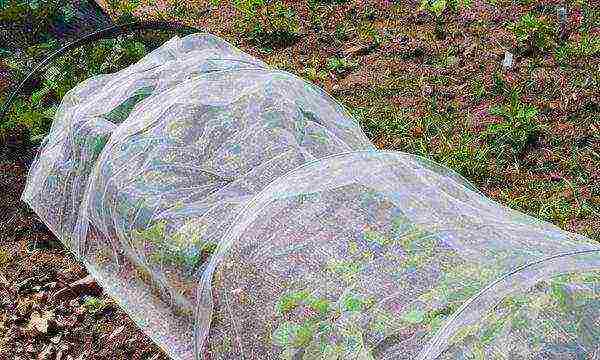 In case of night frosts, it is necessary to build a shelter for strawberries.
In case of night frosts, it is necessary to build a shelter for strawberries.
Summer landing and cultivation is carried out, as a rule, by additional planting, in the holes empty after the death of the bushes, purchased seedlings. By June-July, hardened seedlings of berry bushes will be on sale.
The main condition will be disembarkation of seedlings in the evening, after rain or cloudy weather. Requires abundant (moderate) watering, temporary protection from direct sunlight.
Autumn start from mid to late August. You should not delay too much with this procedure, as the mustache should have time to root well before wintering in the garden. For the climatic zone of the middle lane, it will be optimal to finish planting until the middle of the second decade of September.
Benefits of growing in spring and fall
Each gardener will have to decide on the right time of year for planting strawberry seedlings independently. Both methods are used in the cultivation of garden berries and have their own advantages and disadvantages.
When planting in spring:
- The bushes have time to root and grow well over the summer, which significantly increases their chances of successfully overwintering and giving a bountiful harvest next year;
- Ridges under the spring cooked in autumn;
- When planting early seedlings shelter or hardening required, long-term care;
- The planting of berries is added to the huge list of spring works.
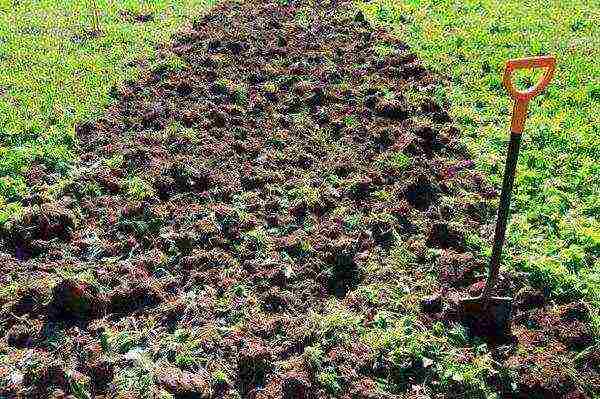 When planting in spring, the soil is prepared in advance, from autumn
When planting in spring, the soil is prepared in advance, from autumn
When planting in autumn:
- You can use your own planting material taken from mother plants;
- Berries on the bushes will appear next summer;
- Ergonomic use of the site. In summer, future strawberry beds can be used to grow vegetables and plant strawberries after harvest.
Thus, the autumn planting of rooted whiskers saves the gardener's energy and time, but is more exposed to the danger of freezing during the winter without shelter.
Important rules when disembarking
When planting young berry bushes, the following rules must be observed:
- Never post strawberry planting after plants of the family Solanaceae (tomatoes, potatoes, peppers, etc.);
- Change the location of the strawberry plantation on the site at least once every 3-4 years... Pests and diseases characteristic of this garden culture accumulate in the soil;
- Do not plant plants close to each other. Affect the quality of the crop;
- Carry out all measures to prepare the site for seedlings (fertilization, disinfection, moistening, loosening, weeding);
- Responsibly treat the choice of quality seedlings and the right place for planting them.
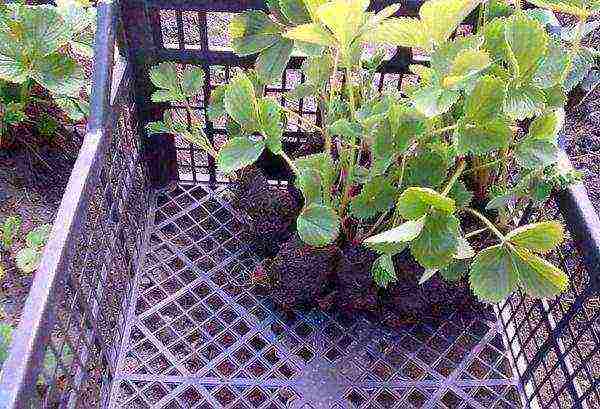 It is important to choose quality seedlings for planting strawberries.
It is important to choose quality seedlings for planting strawberries.
Care after planting and harvesting
In the first days after planting a young plant in a permanent place, it is necessary water regularly and cared for properly. The moist soil around the bush promotes the rapid formation of new roots.
It is important not to overdo it with watering, since excess moisture in the area can provoke root rot and the spread of various diseases: gray and root rot, powdery mildew, etc.
Mulching the ridge with sawdust or straw will help preserve moisture in the soil.
Due to the layer of mulch, many parasites whose larvae develop near the surface of the earth cannot lay clutches in the upper layers of the soil. It is desirable to carry out it several times a year (3-4 times).
Caring for autumn seedlings and fruit-bearing bushes is quite simple. Produced weeding, loosening the soil around the bush.
All old foliage must be removed (trimmed). For the winter, shrubs are covered with a layer of fallen leaves or other improvised means.
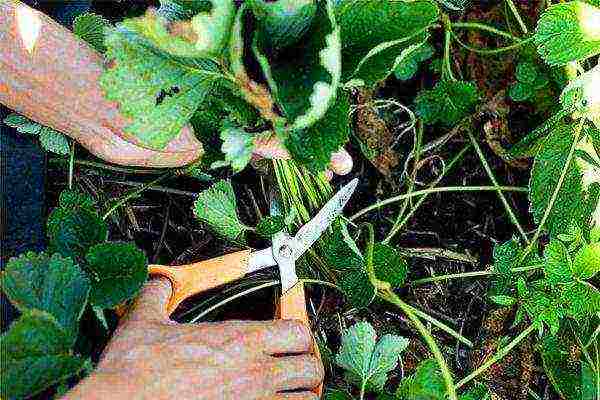 After the end of the harvest, old leaves must be removed.
After the end of the harvest, old leaves must be removed.
In the spring, strawberries need more attention:
- Plants are sanitized (Fitosporin, Phytocid).
- From young plants remove all mustache and peduncles... Cut off last year's leaves;
- In several stages they carry out complex feeding plants with mineral and organic fertilizers (compost, humus).
How to plant correctly
The berries are grown both in open and closed ground (greenhouses, hotbeds).
There are many ways to plant strawberries:
- The easiest, but not the most requested way is carpet... Strawberry shoots spread freely and take root in the entire area allocated for it. The yield from such plantations is low, and the berries themselves are rather small;
- The most common way is planting in rows... Plants are planted in one (several rows) with a distance of 15-20 cm between the bushes. The next row is planted opposite at least 30-40 cm from the first;
- Planting in separate bushes provides that the distance between plants will be at least half a meter. Timely removal of all creeping shoots will exclude the possibility of intertwining berries.
- Nesting the method looks like a mother plant surrounded by several rooted whiskers (up to 5-6).
Preparation of seedlings
Correctly selected berry seedlings for planting are the key to a rich harvest in the future.
They can be purchased in a nursery, or grown independently by rooting a mustache from well-proven mother bushes.
Young plants must be healthy:
- leaves (4-5) smooth, shiny no damage or stains;
- root collar in diameter not less than 6-7 mm;
- developed root system about 10 cm (longer roots can be cut).
Before planting, seedlings with an open root system are etched in a 10% manganese solution. Rinse with water. Sprinkled with growth stimulants (soaked in the root) and planted in a permanent place.
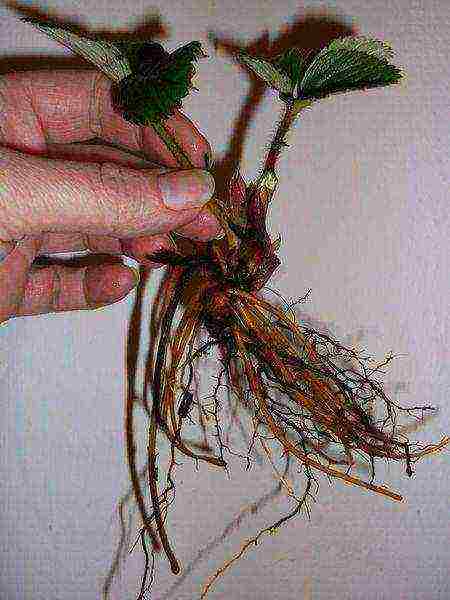 Before planting, seedlings with an open root system are treated with a manganese solution
Before planting, seedlings with an open root system are treated with a manganese solution
Seat selection
The best option for a strawberry bed would be sunny area of your garden, sheltered from the wind.
The most favorable slopes are considered to be with a slight slope of 2-3 degrees on the south or southwest side of the garden. For a berry grower with a well-developed root system, groundwater close to the surface (less than 60 cm) poses a serious threat.
When choosing a plot for strawberries, do not forget the nuances of crop rotation. The culture is not too demanding on the soil, but prefers light and fertile substrates with low acidity... The plant is responsive to the introduction of organic fertilizers and fertilizing into the soil.
Landing
The area under the ridges of berry bushes is pre-dug up, choosing all the roots of weeds. On heavy soils with dense soil, before digging, the earth is covered with baking powder (sand, sawdust). Fertilize the ridges with humus, compost, ash, azofoskoy.
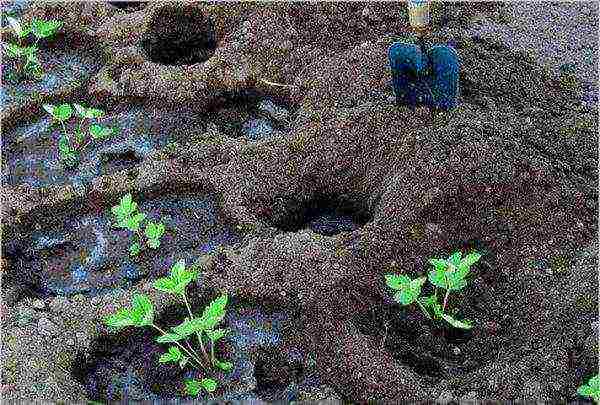 Strawberry seedlings are planted in a hole with a diameter of 15-20cm
Strawberry seedlings are planted in a hole with a diameter of 15-20cm
The seedling is planted in a hole with a diameter 15-20 cm and depth up to 10 cm... If the soil in the bed has not been prepared in advance, then the nutrient mixture should be applied immediately to the planting hole.
The well is spilled with a manganese solution. The seedling is lowered into the hole, straightening the roots (with an open root system), and sprinkled with earth. Water, slightly compacting the soil around the plant, and mulch with sawdust.
The main condition for planting is the correct location of the center point of growth relative to the soil surface. They must be at the same level.
Otherwise, the plant will die:
- at a high location - will freeze in winter;
- when deeply buried into the ground - it will get wet and rot.
It is difficult to overestimate the impact of measures for planting young plants and their subsequent care. It is at these most important stages in the life of a berry bush and lays the foundation for a bountiful harvest.
The taste and size of the berries, the ripening times are determined by the characteristics of the cultivated varieties, the rest depends on your hard work. Be sure that a bountiful harvest of fragrant berries will more than reward all the efforts of a gardener.


